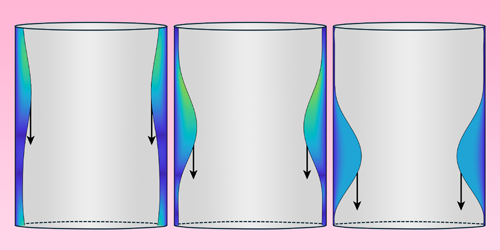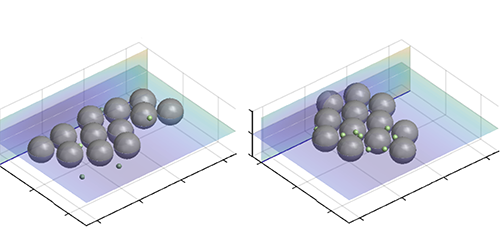October 28, 2025• Physics 18, s133
Fluid flow and acoustic waves act together to trap nanoparticles.
A. Pavlič and T. Baasch [1]

A. Pavlič and T. Baasch [1]
Acoustic trapping uses radiation pressure from sound waves to immobilize red blood cells or other micrometer-sized particles against an external liquid flow. These and larger particles feel the weak force generated by acoustic waves, whereas smaller, nanoscale particles are swept away in the flow (see Synopsis: Trapping Large Particles with Sound). Yet more than a decade ago, engineers made a surprising and puzzling find. Nanoparticles, such as extracellular vesicles, can be trapped by acoustic fields provided that they are mixed into a liquid suspension of microparticles. Alen Pavlič of Caltech and Thierry Baasch of Lund University in Sweden now have a solution to the mystery [1] .
The two theorists modeled the behavior of spherical particles in a shallow liquid cell placed in an acoustic pressure field and driven by a background flow. Their simulation started with a set of 12 “seed” particles (5 µm diameter) and 13 “target” particles (500 nm diameter) and tracked the forces acting on each particle owing to background effects and interactions with its neighbors. Different flow rates, acoustic field strengths, and particle mass and size combinations were explored.
The study showed that the large seed particles shielded the smaller ones from the background flow. As a result, the smaller particles felt a lower drag than they would on their own. Meanwhile, waves scattered by the large particles converged to create wells that trapped the small particles, acting like a glue that prevented the nanoparticles from escaping. These acoustic interactions were negligible in a system with small particles alone.
Pavlič and Baasch concluded that nanoparticle trapping arises from a combination of hydrodynamic shielding and acoustic-driven interactions. The pair says that the finding could potentially underlie a new method for separating biological particles by mass density.
–Rachel Berkowitz
Rachel Berkowitz is a Corresponding Editor for Physics Magazine based in Vancouver, Canada.
ReferencesA. Pavlič and T. Baasch, “Acoustic nanoparticle trapping is driven by synergy between acoustic and hydrodynamic interactions,” Phys. Rev. Lett. 135, 187201 (2025).Subject AreasRelated Articles

 More Articles
More Articles

